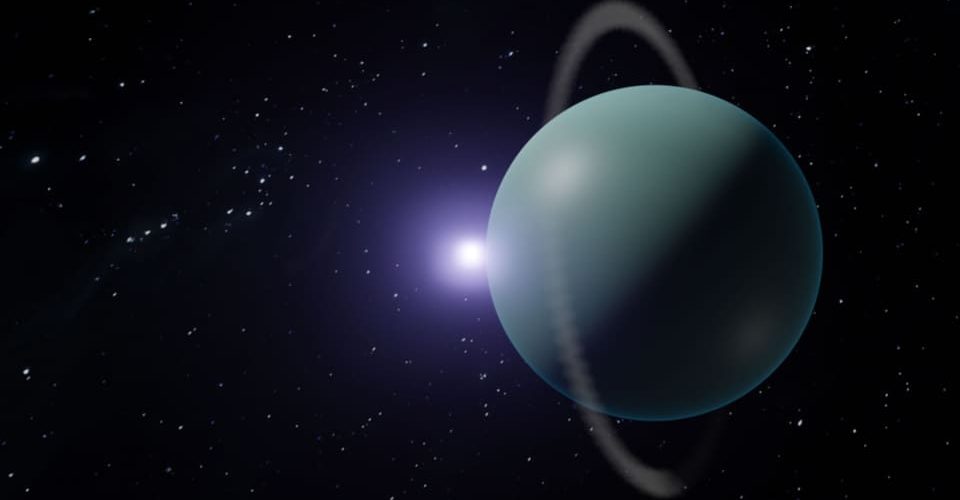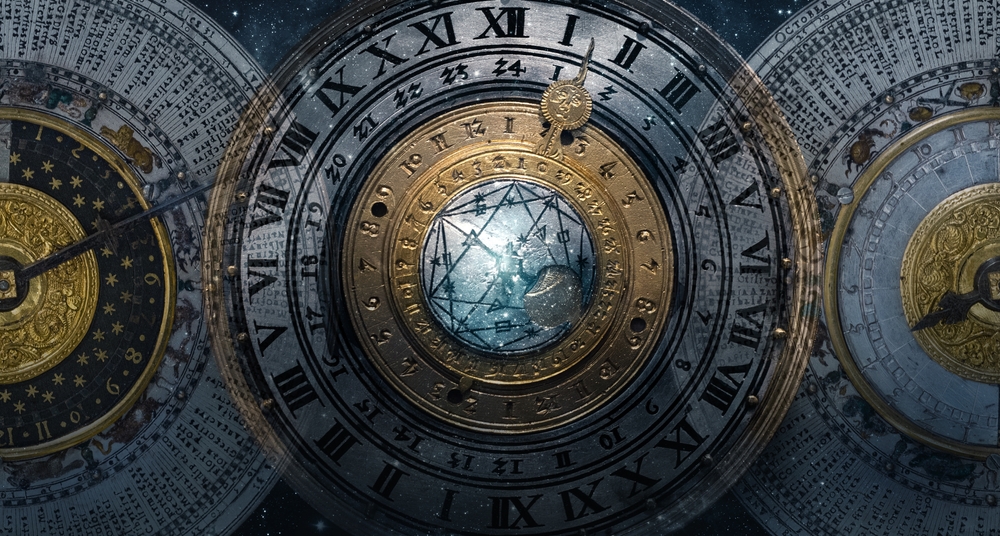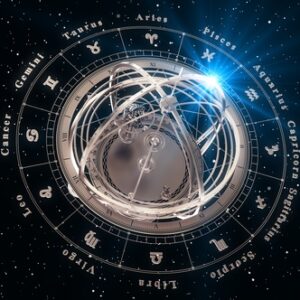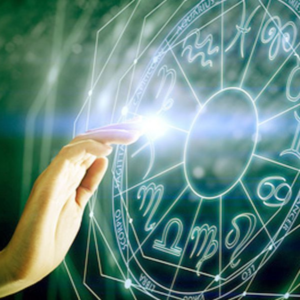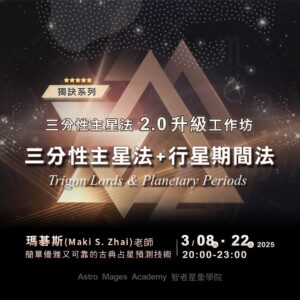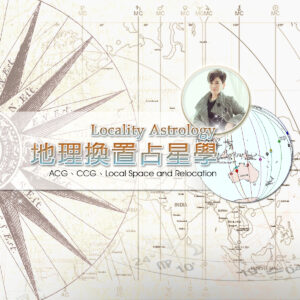〈前一集〉
The Discovery Charts |發現行星的事件盤
為一個事件(即已發生且在某種程度上被視為重要的事件)建立一張星盤是普遍的作法,尤其是事物剛開始的星盤,例如事業的開始(可能是公司成立)、婚姻的開始(婚禮)等等,也包含占星學最為人所知的應用:誕生星盤(birth chart),也就是生命的開始。從這些星盤可以獲取與事件相關的資訊,並對事業、婚姻或生活的發展進行預測。
這樣的星盤是為某件事展開的重要時刻所起的盤,當然,每一種情況或人生中還有很多其他重要時刻,但「出生」當下就是後續所有的關鍵。
占星家透過對每一顆土星外行星被發現的時刻,計算星盤以進行推敲,獲取關於「發現」這一行動的「生命周期」資訊,而非被發現之物體的相關資訊。我們也許會找到關於「發現」的本質,在這樣的情形下,它可能是天文或星象上的描述,但發現行星這件事不能被視為是一個「誕生」,無法提供我們關於那顆行星的性質資訊。這些事件盤並不提供與該行星相關的性質與質料的資訊,但顯然,過去這些事件盤被用來獲取這一類的訊息了。
這種做法的邏輯顯然是有疑慮的,但在發現冥王星的時期,卻鮮少受到關注。在接下來對每一顆行星的探討中,將提供發現行星的事件盤及其相關要點,而就天王星的部分,也會對其描述的內容進行示範。
Uranus (discovered 1781) |天王星(發現於西元一七八一年)
天王星的象徵意義,其來源是多元的,包含發現行星的事件盤、天文特徵、當代政治事件、科學的進展、烏拉諾斯神話、神智學教義以及對占星系統上的誤解。我們將逐一進行檢視,但首先必須觀察年曆編撰者在處理天王星時,其嚴謹的程度。
Early References |早期參考資料
調查天王星被發現以後的曆書(almanacs),預期應能觀察到天王星被納入占星學體系的發展,特別是考量到當時缺乏其他出版著作,因此,這些常態性出版的刊物便成為很好的潛在資訊來源。但如同先前的解釋,與過去幾個世紀相比較,這些曆書的占星內容,水準偏低,只要有新穎的內容,便可吸引更多讀者以衝高利潤。因此,雖可預期編輯與出版商都有持續跟上新發現的腳步,但假設利潤是種激勵的因素,便可想見占星數據的準確度就成了次要的考量。
直到西元一七九四年,曆書編撰者才首度承認天王星的存在,但僅以名稱與符號表示59,有時會出現在曆書裡的星盤,但無法用來回溯過去。因此,以本命星盤為例,如果出生於天王星被發現之前,那麼本命星盤就不會標示天王星。此外,天王星到西元一八二七年才被列入相位列表(lists of mutual aspects)。
在西元一八四七年的錫德年曆(Seed’s almanac),將天王星納入了星曆表,並且以符號的方式出現在與月亮有相位的章節60。錫德稱它為赫雪爾(Herschel),而且,僅在處理氣象相關問題時才考慮它的相位。他還經由「他(he)」這個代名詞為天王星賦予男性的性別,也提供了天王星、灶神星(Vesta)、婚神星(Juno)、灶神星(Pallas)與及穀神星(Ceres)的赤經緯座標資訊61。納入這些小行星(asteroids)顯示當時的流行趨勢,而非開啟占星的先例。儘管這些小行星被列入曆書,沒有證據顯示書中對這些小行星進行了應用或詮釋。
曆書裡幾乎找不到關於天王星的意義,即使到了西元一八六五年(發現天王星八十四年後),當天王星與另一行星有相位時,也只有一些關於氣象預測的保守詮釋。概略地瀏覽曆書,也鮮有提及天王星,它是突然以「喬治之星」(Georgium Sidus)的字符形式出現,被帶入氣象預測中,不過,這對於詮釋幾乎沒有幫助。這種低調,與發現冥王星時某些占星家更為自信的作法形成鮮明對比。
有證據顯示,天王星的占星象徵意義是有爭議的:
許多人假意預測本命星盤,爭論喬治之星(譯註:指天王星)以及其他四顆近期發現的小行星(婚神、穀神、灶神與智神星)的力量。在我所有的解盤中都會忽略這些小行星,原因很簡單也顯而易見,因為我確信還沒有任何例子足以證明它們的影響力。目前這些小行星真實確切的位置、公轉等資訊都還未知,若用於星盤的演算和判斷,應該很快就會發現錯誤。我曉得有些人會說他們發現這些小行星於本命星盤中的影響力,但他們應當提供實質的證據來證明,而我敢肯定他們無法提出解釋。如果有人反對我在此的陳述,也懇請他們別置身事外,可以站出來向全世界發表他們從合法的實例與經驗中所找到的觀察結果 62。
顯然,很少有占星家願意或有能力回應這樣的挑戰。這位作者不僅駁斥天王星被賦予的象徵意義,他還質疑天王星在占星系統中的地位。文中提到的「合法」指的是符合既定的法則,或是符合以實證為例的神學意義,而非信仰。
The Discovery Chart|行星發現盤
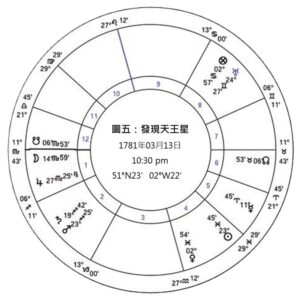
這張行星的發現盤,顯示的是普遍接受的時間,即威廉.赫雪爾(西元1738-1822年)在他位於巴斯(Bath)的家中發現天王星的時間63。這項發現之所以具有重大意義,不僅是占星學的理由,而是,占星家原以為會在四軸點找到天王星,但在這裡,並沒有看到這樣的現象。天王星位在第八宮,以這顆行星來說是個平淡無奇的開端64。從這張星盤中天王星的位置來看,似乎沒有與天王星明顯相關的象徵意義:第八宮是不幸的宮位,通常被稱為「黑暗」,主管著死亡,然而,天王星卻從未汲取這樣的象徵意義,反而是留給了冥王星。
這張星盤所提供的描述很明確,赫雪爾想有個觀察這顆行星的最佳時機。我們可以看到星盤上的月亮尚未升至地平面,因此,他的確有個適合觀察星體的黑暗夜空。我們看到火星—上升主星,代表赫雪爾本人,他觀察位在天空南象限的天王星,隨著月亮三分相入相位太陽,象徵性地向赫雪爾揭露了這顆行星。傳統上,發光體主管眼睛,在這裡則是象徵望遠鏡,而日木三分相位則象徵清晰的視野。
天王星最顯著的相位結構是從火星而來的緊密對分相,以及從土星而來、較為寬鬆的對分相;兩顆凶星。占星家確實將火星與土星的性質歸屬於天王星,且行星的發現盤也提供了該象徵意義的關鍵。拉斐爾 (R.C. Smith 1795-1832)是早期提出這種詮釋的代表人物,他解釋「古人」如何詮釋新出現的「星象」(根據所在的天空象限、星座和任何靠近的恆星),但之後,他似乎對這不予理會,而建議用首次觀測到新行星的星盤,「對學生來說,用這種方式來顯示新行星出現的特定原因,會比其他方式更為明顯」。
拉斐爾使用的星盤時間是西元一七八一年三月十三日的晚上十點,因為是長上升星座(天蠍座),所以半小時的差異並不大會改變星盤的結果(譯註:指詮釋星盤的結果)。拉斐爾指出天王星出現在第九宮,但是,大多數的宮位系統均顯示天王星位在第八宮。雖然他也指出土星位於代表財富的第二宮,但他並未對此做出結論。
「當然,天王星的發現盤已經清楚表明天王星會帶來不幸的影響 —占星家們曾經證實這一點— 因此很容易得出,凡觀察到天空中出現任何新的或不尋常的星象時,都必須遵循相同的規則 。」65
他對於所說的並沒有提出佐證,也沒有嘗試運用古老的法則(沒有提供來源),那麼這個建議的做法自然是不夠謹慎的,甚至是草率的,但這般異議,終究,沒有說服力,因為我們發現該步驟已被採納為實際的做法,並在之後,被應用了近六十年:
「最優秀的現代占星家認為赫雪爾(譯註:指天王星)具有土星與火星的性質 66,……」
再後來,其象徵意義甚至被反轉了 —火土合相被視為與天王星的性質相像—強化了天王星日益增長的重要性:
當火土合相時,理應是個和諧的整體,但實際上並非如此,因為這種結合在某些方面來說,與天王星的影響力沒有不同 67。
這裡需要強調的是,這張星盤是根據發現天王星的時間與地理位置所設定,因此星盤是針對該事件的描述,而不是天王星本身。星盤只是單純地依照數理架構配置了行星的位置,其目的是為了便於區分。星盤無法用來描述星盤中的敘詞(譯註:指行星)。
Astronomical Characteristics|天文特徵
與太陽系其他行星比較,天王星是超乎尋常的,它向側邊旋轉,因而得出個人的怪癖、不尋常的事件以及行為的象徵意義。
同樣地,在太陽系中,天王星作為土星之後的第一顆行星,被認為具有打破舊有界限的意涵,這些界限過去代表太陽系最外層的邊界。因此,當連結到對烏拉諾斯神話的誤解時(如後說明),天王星便與叛亂、獨立、革命、動盪和推翻既定立場有關。天王星代表新的和進步的,而土星代表任何舊的、保守的和過時的。
值得注意的是,土星因此與邊界和限制有關,這是目前仍保有的象徵意義。
Political Events |政治事件
占星家將天王星的發現與美國獨立革命相連結,後者以西元一七七三年的波士頓茶黨事件(Boston Tea Party)為前奏,始於西元一七七六年的獨立宣言(Declaration of Independence)。西元一七八一年,英國人在約克鎮(Yorktown)遭到擊潰後,確定了美國的獨立,同年也發現了天王星。西元一七八九年的法國大革命導致法國君主被處決,隨後建立了共和國,這也與天王星有關。這些都是震驚世人的事件,卻從未與英國內戰(British Civil Wars,西元一六四二至一六五一年)進行比較,後者對國家也造成同等的創傷及長遠的影響;查理一世(Charles I)在西元一六四九年遭到處決,這被認為是可怕的行為,即使是保皇黨(Royalist party)的反對者也如此認為。
火星是戰爭之星,甚至是內戰、謀殺與混亂之星,無關乎戰爭的起因與敵人來源。法國和美國的革命都奠基於皇室及政府的暴政,這與英國內戰的原因完全相同,從許多面向來看,都是一場革命。
從現代事件抽取出天王星與革命、動盪、獨立和自由的相關意涵;這些狀況被視為是現代的,因而不屬於火星的象徵意義。
Scientific Advances |科學的進展
啟蒙運動從西元一六五○年持續到一八○○年代,幾乎是發現天王星時期的尾聲。隨著工業革命的展開(西元一七○○至一九五○年),穩固地確立了人們對理性主義(rationalism)的追求。蒸氣幫浦(托馬斯.薩維里Thomas Savary, c.的專利,西元一六五○至一七一五年)是工業革命最重要的發明,確立了工業革命的開始,沒有它就不會發生工業革命,然而,占星家並未提及這項發明。同時期占星家出版的著作裡,只提及看似與天王星相關的發明或進步,卻從未提到蒸汽動力才是引領工業發展的起因;他們將這兩者分開來考量。
正因為將十六與十七世紀科學革命的科技應用於工業,才促成十八世紀的工業革命,而事實上,這正是工業革命的定義。占星家讚揚天王星是科學、天才、獨創性和邏輯之星,實際上這些性質與動機是屬於天王星被發現之前的時期。
電力是個很好的例子,能說明占星家對於自己所處的時代進步,其膚淺的理解如何讓他們誤入歧途。他們認為天王星掌管電力,因為兩者皆在同一時期被發現,然而威廉.吉伯特(William Gilbert,西元一五四四至一六○三年)在他西元一六○○年關於磁性的《論磁石》(De Magnete)著作中,便已首度描述了電力,電磁科學的研究也正是由他開始,到了十九世紀才證實磁力與電力間的關聯,進而引領電流的發展。在發現天王星的五十年後,法拉第(Faraday)才發表了電磁感應定律,爾後他繼續將此發現應用於發電機和變壓器,這也是大規模發電與供電的兩項必備發明。
當占星家將電力與天王星連結的時候,尚不清楚他們在談的是什麼,然而,他們認為這種「新」的電力(相對於自然發電)需要由一顆新的行星來管轄。他們發表的資料沒有提供任何關於這種「新」形式能源性質的論據,因此無法斷定他們是否曾經接受—電,是完全由化石燃料所產生的這項事實:即「舊」的事物自然屬於「舊」行星的管轄範圍(例如由土星主管的煤炭),而電力,無論何時發明,都是以前就已經存在、並且用來為蒸氣幫浦提供動力的燃料產物之一。就最終結果來說,電流都是從自然產生的能量類型中製造而成的成果。由於這種能量既熱且乾,應屬太陽或火星的管轄,因為太陽是所有熱與光的來源,而小凶星火星則是執掌閃電與火,這兩者都提供了合理的象徵意義。
也許是因為西元一七八三年首次進行了熱氣球(孟格菲兄弟Montgolfier)的載人飛行,航空及太空旅行的奇蹟也歸功於天王星,然而,在西元一三二五年的佛蘭德手稿(Flemish manuscript)中便已能找到第一個拉繩直升機(string-pull helicopter)的插圖68。熱與氫氣能為氣球提供飛行的升力,但熱與氫氣並非是新奇的東西,算是自然的存在,它們也是由蒸汽、氧氣和甲烷,或是由蒸汽與焦炭所生成;而甲烷或沼氣則是由有機物在無氧情況下分解而成,是天然氣的主要成分,自西元二世紀以來便一直被應用於照明。這也有助於對太空飛行的理解,即過去實現太空飛行的最大障礙,是缺乏能夠產生足夠推力來舉起大型火箭的燃料,而這都透過液化燃料克服了,尤其是氧氣與氫氣。
因此,天王星的象徵意義只剩下以現有的科學應用,實現與天王星相關的新技術。雖然,現代科學將電力應用在多種領域:暖氣、照明,以及啟動現代電器所需的能量—電力為我們保暖、提供照明、為工具提供動力,但火也同樣可以為我們保暖、照亮我們的家園,而風和水也能夠為工具提供動力。我們不該假設電力中央暖氣系統在本質上不同於羅馬人的地下暖氣系統,或是光的性質已經改變。烤爐可以用來烤肉或烘焙蛋糕,無論使用電力或固體燃料來提供動力,效能或許有差別,但本質上並沒有不同;電就是能源,而這完全含括在傳統行星的範疇。
旅行,也是可以透過如水星和月亮等傳統行星的作用來象徵的活動。一個人用什麼方式旅行並不是那麼重要,這只是媒介而已;儘管它的驅動力或許可以形容這種媒介。因此,舊的帆船仰賴的是風力,或說空氣,而將太空船升至地球引力之上的火箭,本質上是由空氣和熱所驅動。太空航行的艱鉅和危險正好對照幾世紀前的探索之旅,第一位歐洲人在美國土地上留下的足跡,就沒有第一位人類在月球表面上留下的足跡重要?
電腦會透過電子學和電力執行數學函數的計算,而數學計算則是由水星所管轄,因此,無論是算盤還是電腦,都屬於水星的活動;科學屬於水星的範疇,因為它在本質上是智力的活動,至於科學或智力應用在什麼主題上並不重要。科技是應用科學,這並不是什麼新鮮事,印刷機也曾經是前衛的尖端技術。從廣義而言,占星學是一門科學,部分屬於智力活動,因此由水星所管轄。
天王星象徵天才和獨創性,有部分似乎是從這些科學進展和發明所推斷出來的。在神智學占星家以如此自信的方式形容天王星的時期,標示著當時人們對科學家也具有同樣的信心,當代科學被視為是智力成就的巔峰。
「我們正處於新時代的起點(我們希望如此,如果想延續文化,這是必然的趨勢)……這是民主的時代,但也是科學的時代。」69
如同接下來所說明的,獨創性成了占星家的口號,成了追求占星(以他們的說法就是天王星)卓越的驅動力。
對獨創性的推動以及想要獲得科學認可的渴望,某程度解釋了他們一再重複講授對其占星象徵意義所做的判斷,以及透過個人經驗和實踐的方法。乍看之下,這似乎是明智的教導,完全符合傳統,但若進一步檢視,顯然這只是將個人意見作為規則,而沒有參考既有的專家說法或是原理。他們對實驗的科學原理僅有表面上的理解,只是剛開始去理解透過實驗和經驗證明其理論的原理,因而,這樣的結果不夠充分也不具說服力。
The Ouranos (Uranus) Myth |烏拉諾斯(Ouranos)(天王星)的神話
與天王星相關最著名的神話就是天空之神—烏拉諾斯(Uranus),祂的妻子是大地之母蓋婭。克洛諾斯(Cronos)(後來與土星有關)是祂們最小的兒子,也是唯一同意保護母親免受烏拉諾斯傷害的兒子,祂閹割了父親,並取代父親在天上的地位。70這往往被占星家解釋為展現反叛(天王星)的衝動,71但他們似乎忽略了採取行動去反抗烏拉諾斯「既定權威」的是土星,而且祂這麼做是為了回應母親的求助,而非為了反抗父親。克洛諾斯,或者說土星,因此成了天空和大地之王,直到他被自己的兒子宙斯(木星)所擊敗。
證據顯示,後來的占星家採用了這則神話,這則神話受到了誤用,體現了印刷文字的力量。而這項錯誤至今仍持續存在,因為很少有人會質疑它的真實性,他們相信自己讀到的內容是可靠的。
Theosophical Doctrine |神智學的教導
教育、知識、思想和邏輯的傳播,以及科學和技術(如前所述)都屬於水星。神智學占星家顯然知道傳統的象徵意義,而且也都接受:
古代占星家已經描述了來自每顆行星的特殊影響,而他們顯然是受到知情者的教導,因為如我們剛才所暗示的,現代的學生透過學習和實踐發現,就每顆行星的性質來說,基本上前人所述的都是真實的。72
然而,這並沒有阻止他們將水星的象徵意義視為天王星所有,而這,當然會引發占星詮釋的問題,因為不可能將這兩顆行星的作用分開;儘管有些含糊其辭,以下的引文有提到。雖然作者對於天王星和海王星的性質抱持謹慎的態度,但這樣的謹慎,隨即因在其他地方冗長解釋它們的影響力而顯得矛盾。
或許可以肯定地說,占星家相當熟悉除了天王星和海王星以外不同行星管轄的習性,而占星家對天王星的了解又勝過海王星。就目前的經驗而言,天王星和海王星似乎代表著某種氣質的兩個極端,如果沒有更好的詞可以形容,或許可以稱之為靈性的。73
水星和天王星的劃分方式變得越來越清晰:七顆傳統行星構成了「顯義」(exoteric)或「唯物主義」(materialistic)的占星基礎,而新行星則是神智學占星家非常重視的「密義」(esoteric)或「靈性」(spiritual)的部分。
從艾倫·里奧(Alan Leo)的所有著作都可以明確觀察到這樣的強調,而在他之後其他人發表的著作也有如此的暗示。
希臘人曾堅守(迦勒底人的)傳統一段時間,但對他們來說,這項研究逐漸成了一門藝術而非科學,此時的相關教導也已經衰退,幾乎無法從我們所知的希臘作家身上找到原始的真相,遺留給羅馬人的渺小占星生命,最終也被視為祕教而受到摧毀。儘管如此……它在羅馬帝國初期曾蓬勃發展,雖然是以通俗的形式……後來漸漸式微而形成所謂的決疑占星學(judicial Astrology),最終發展成僅是用時間進行卜卦的占星形式(卜卦占星學)。……儘管應對努力捍衛這門學問的近代傳承者給予尊重,但我們不得不承認,他們的研究夾雜了過多屬於「卜卦」占星的考量,那是一個無法與東方智者傳授的占星實踐方法相比的系統。74
神智學說的「密義」占星學顯然獲得了優先考量,甚至是優於他們所稱的「顯義」占星學。正因他們在其象徵性意義的應用所引發的困惑,讓人難以將其學說的動機,與不充分或帶有偏見的占星知識和理解區分開來。
因此,要從天王星區分出水星的意義,首先必須接受天王星是一顆具有「靈性」或「密義」意義的行星,做到這一點之後,神智學的讀者必須接受「八度表達」的概念。在這樣的情況下,天王星被視為是水星的「高八度」:因此,例如水星主管智力,天王星主管天才;水星主管溝通,天王星主管的便是「更崇高」原則的溝通。
當然,「八度表達」指的是更微妙透徹、更精緻細膩的發散類型,大致上可被視為和較低的展現具有類似的基本性質,這暗示了它的本質,甚至可說是精髓,就像是樂音的高八度和較低的音階,其發音於根本上沒有不同,它只是由更多的振動所組成。連續八度音階的振動可能變得如此快速和繁多,唯有最敏銳細膩的耳朵才能分辨得出來……75
因此,天王星的功能(或說,它的影響所帶來的「回應」)作用在屬於較高層次的靈性進化。
有人提出,針對人類事務的影響力而言,天王星和海王星於靈性上都是與水星和金星相當或對應的,這相當符合占星上的經驗,或許也是天王星在知識界製造怪人、而海王星怪人出現在藝術界的原因。他們可能接觸到的思想和感受到的元素,對於較世俗的金星和水星類型的人來說,是完全無法想像的。76
古怪、獨創和獨立被視為新的特質,不屬於傳統行星「七位一體的設計」,77而是屬於它們自己年代的特質(儘管這些「天王星」特質後來也用於形容過去年代的人,尤其是天才的部分),顯然只有新的行星才能適當地表達。
然而,問題依然存在:要如何分辨是否對新行星的影響力做出正確反應的人。
占星學首要的困難大概是:我們無法根據目前的知識得知特定的影響力會顯現在哪方面;這尤其適用於較遙遠的星體,因為這些星體已經超越了我們目前發展的基準。由天王星所主宰的可能意味著天才—機械、科學或鼓舞人心,或在較低層次代表在智力或在實務方向(例如企業倡議……)廣泛地表達其獨立的觀點,又或者可能暗示缺乏控制或古怪,尤其是位在上升點時,又或是在虛弱的星盤中特別突出。78
這些問題沒有獲得明確的答案,他們堅信未來的占星家將能透夠過經驗提供解答。我們再度獲得這樣的指示:經驗可以是唯一的老師。79他們顯然正在犯錯,而且還會繼續犯錯,而他們處理這些錯誤的方法就是賦予天王星以下的象徵意義:
「將會發生突如其來的意外事件,而且以不可知的方式發揮作用,讓人無法精確判斷究竟在它的振動下會發生什麼事。」80
從不疑問任何關於天王星象徵意義的有效性,或它是否包含在占星系統中,在這種情形下,行星本身要為占星家無法預測行星作用而負責。這充滿漏洞的邏輯只能被歸為神秘主義的藉口。他繼續表示:
現在可以肯定的是,古人知道有天王星的存在,但只有非屬常人的人士才會受到它的影響,而且可能是出於目前還無法解釋的神祕又深奧的原因。
他如此肯定的原因尚不明確,但這並沒有阻止里奧或其他神智學派的占星作家,他們仍繼續提出類似的論點來支持他們的占星系統,把這問題的事實解釋成:一般而言,天王星在當下的影響不大;它是代表未來人類的行星。
然而,有一項限制條件、或說是修改因素,在一般實務中強加了某種限制:也就是說,由於這兩顆行星顯然只涉及現存較少的人,或更確切地說,它們的真實本質只會在自我發展到一定程度時發揮,而且也只能在這種情況下運作,因此,絕大多數人由於無知和濫用,導致「置換」(permutation)的發生,因為神性和人性是對立的。在這種情況下,可以預料到星座和行星會不一致,真正的星座主管權(水瓶天王星、雙魚海王星)陷入窘境,只好暫時擱置。81
他們對天王星的描述顯然無法令人滿意,因為他們賦予天王星的象徵意義無法運用在實務中,但他們從不承認,只是加以辯解。
下一步是將天王星安插到星座主管權的結構中。顯然,他們有些猶豫,但似乎沒有持續太長時間:
「天王星主管的範圍難以判定,因為它沒有自己的宮位(星座),儘管它是最適合被配置在風象星座。」82
一旦天王星被分配主管的星座,問題就會倍增,因為不只必須區分隸屬水星和天王星的「較高」和「較低」類型,也必須區分由傳統主星土星守護的水瓶座,以及由新主星天王星所守護的水瓶座。在解決「高低八度」的問題之後,以下是處理土星惱人糾葛的一小步:
從占星家、神智學家、祕教主義者、神祕主義者及靈性提倡者,或任何領域密義思想的揭示者等人身上發現進化的自我,令我確信,我們太陽系中遙遠的兩顆成員天王星和海王星將被視為守護水瓶座和雙魚座兩個黃道星座的主星。83
毫不意外地,他們應將自己視為「進化的自我」的擁護者,且毫不猶豫地擴展新發現行星的星座主管權,並在需要時改變系統來加以迎合。里奧在他早期的作品中告訴讀者,儘管天王星和海王星的星座主管權尚未被決定,但應當接受它們是替位於太陽和月亮。84至於他自己的想法是:
他有一段時間都相信天王星和海王星分別守護水瓶座和雙魚座,而且,他在直覺上無法超越這個想法。85
再次地,比起耿直的研究和深思,直覺獲得了更高的重視。對此沒有提出懷疑或問題,因為這既然是在神智占星學背景下所做的陳述,便認為直覺是適合用來研究這些事項的方法。
天王星被分配守護水瓶座,因為說它是水星的「高八度」。在他們的系統中,因為水星入旺於水瓶座,因此天王星被配置在水星的旺位。86而土星作為古老的星座主星,因而可保留部分的主管權,但僅限於較低階的部分:
雖然一些水瓶座的人仍存有土星限制性的影響,但在其他人身上,天王星較高層次的影響力則更為顯著。……而那些對天王星較高面向較無反應的人大多會受到土星限制性的影響。又即使是較高類型的水瓶座人,部分面向的土星影響力將仍會相當顯著……在仍以土星元素為主導的領域,動機可能完全是出自於物質的且自私的,而即使受到天王星理想原則的啟發,最好的情況是實際的且具有土星特質。……在這個星座中會找到許多極為不同的類型:非傳統(天王星)和傳統(土星)。87
視進化程度而定,太陽水瓶的命主可能展現出天王星或土星的特質,或是他們也可以兩者兼具。這幾乎沒有留下需要承認錯誤的空間,由於沒人真正知道該如何定義與新行星相關的較高和較低的類型,占星家無須為不正確的描述負責。
「這些(對星座的)主管權不僅是建立在傳統之上,也是根據觀察而奠定;」88
前述所謂的「傳統」從未被揭明,而這裡所指的亦非是西方預測的傳統。事實上,考量到過去時代的占星學並未受到重視(除了他們所稱的迦勒底時期以外),若有用到任何以前的做法將令人意外。一再提及「觀察」和「經驗」是為了替他們的活動提供科學基礎,然而,他們似乎忽略了這樣的事實,即他們自身的「觀察」和「經驗」未能提供一個可靠的系統,或一個能夠一致地應用於實務的天王星象徵意義。
只要簡單檢視一些歷史事件便能為這些評論提供證據(譯註:指本文作者的評論)。太空探索和旅行是最為堅決地被分配給天王星,因此應可預期在這些相關事務的星盤中,天王星會特別突出。首先,最重要的是第一顆人造衛星Sputnik 1的發射星盤,它標示著太空時代的開始。89
天王星的位置一點也不顯著;然而,它與天秤星群形成六分相,並與土星射手形成三分相。更重要的是,月亮位於七宮水瓶的風象星座,而這可以描述為乘風(水瓶座)去旅行(月亮主管旅行)。金星和土星同樣位於角宮,但這張星盤和衛星的發射有關,因此我們應觀察的是在地平線以上的行星。作為上升星座的主星,太陽也應被視為衛星的象徵星以進行研究。太陽的定位星是金星,即天秤座的主星,而金星位於四宮的地面位置,因此金星代表衛星的控制器。
火星和木星與太陽合相,描述了將火箭從地球引力中釋放(木星)的推進系統(太陽和火星)。月亮本身是空亡的,因此衛星將無法結束它的旅程:它並不打算返回地球。90天王星並未對這樣的概念提供關鍵的敘述。
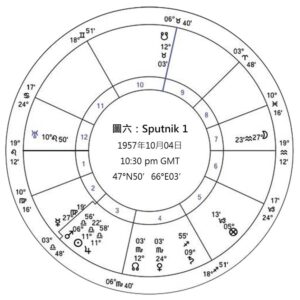
作為開始太空時代的星盤,天王星更是沒什麼可談的,因為它位在果宮和凶宮。當發現月亮位於最後幾度的空亡狀態時,我們可能會懷疑科學家和政治家的預測以及太空探索的實用性。將太空人送上月球之後,也許會被質疑太空旅行還能夠有多少的進展。星盤顯示水星處女位於二宮,火星、太陽和木星位於三宮的風象星座,很明顯的,來自太空科技所能帶給人類最大的利益(如果可以這樣描述的話),是它為我們帶來了通訊等方面的重大進展。
由於俄羅斯到隔天才宣布發射了衛星,因此這張星盤的時間數據並不確定,但如果天王星是一切太空探索相關事物的象徵星,那麼應該要能夠提供更多的訊息。
太空探索被認為始於一九○三年,俄羅斯物理學家齊奧爾科夫斯基(Tsiolkovsky)主張以液體燃料火箭進行太空探索的時候;同年,萊特兄弟成功完成了第一次持續十二秒的動力和載人飛行。
這次的星盤顯示天王星在十一宮,儘管它的位置優於前一張星盤,但就重大時刻而言,仍不具吸引力。91我們見到月亮持續出現在顯著位置,這次是位在第十宮。如果天王星主管航空旅行,應能預期它出現在類似月亮的位置。土星守護上升點,因此也代表飛艇及乘客。土星位在風象星座水瓶座,僅略高於地平線,描述著到達的高度不足。固定星座的配置不利於旅行,因為這會減緩動力,但卻可以貼切地說明僅僅持續十二秒的飛行。
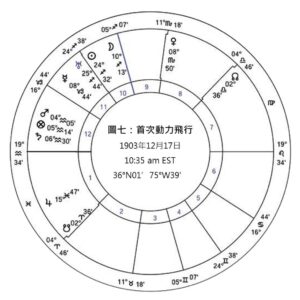
Misunderstanding of the Astrological System |對占星系統的誤解
必須考量的是建構「新」且「科學」占星學的主要動機,而被用來達成的方法是排除法。在為占星學尋找科學基礎時,所有可能被解釋為迷信或不「理性」的都遭到了否決。科學為他們提供了繼續前進所需的憑據:採用實驗和經驗所證明的科學理念,以及對過去所有一切的質疑。如前所述,這在神智學占星家出版的著作中非常明確:
大規模的實驗,無論如何,都為推運星盤(of the Progressive Horoscope)帶來了得以證明其永久價值所必要的經驗和事實……92
里奧探討的是他推運星盤的新方法,但就如同其他地方,儘管使用的是嚴謹的科學語彙,但卻未能提供任何具有科學基礎的證據。
一個改變目標的宣告,再加上缺乏對占星學的理解(這些作者明確表示他們並不了解所承襲的許多占星技術和概念),讓西方的預測傳統走上了瓦解的道路。就是此一時期,他們可以研究某些占星技術,但憑個人經驗就加以否決,並認定為無效。他們幾乎沒有做任何事來確認該經驗的有效性,或盡可能地減少主觀的影響。所有的異議都以「個人經驗」為名推翻,其勢力延續至今。
關鍵的誤解在於區間(’sect’,在前一集的「占星學的基本原理」解釋過)。下面的例子摘錄自早期某一本關於冥王星的書籍,作者說明了行星如何被賦予星座的主管權:
土星為土元素的行星,過去守護一個土象星座和一個風象星座。它保留了對土象星座摩羯座的主管權,這符合它的基本性質,然而它必須將風象星座的水瓶座讓給風象行星—天王星(大多數現代作家都將天王星視為風象行星,但嚴格來說,它是土象兼風象的行星,作用在物質和靈性的層面。作為第一顆外行星,天王星的任務是讓物質變得靈性,釋放和解放水瓶座受世俗約束的特質。這就是為何每當土星出現在水瓶座時,就必須為了管轄權而戰……)。93
他將行星的元素性質與星座的元素配對,而這與系統相悖(譯註:指基於占星學基本原理的系統)。土星的確具備土象性質,但如先前解釋的,這並非是它守護摩羯座的原因。他又繼續將木星描述為是一顆火象的行星,過去守護射手座這個火象星座,以及雙魚座這個水象星座。在新的架構中,木星持續守護射手座,因為符合它的性質,而雙魚座則被分配給多水的海王星。事實上,木星是風象行星,因此在元素上既不符合射手座,也不符合雙魚座。
已沒必要再繼續討論其他所有的行星和星座,但除了水星(由於入廟和入旺在處女,這顆行星已經操練這些占星家一段時間):
最後,土象行星水星保留了土象星座的處女座,將雙子座讓給尚未被發現的第十二顆行星,如果未來有發現這樣行星的話,而我認為這是肯定的。94
水星是水象行星,而且和其他的行星一樣,根據日夜區間負責守護雙子和處女。由於無法理解行星管轄的結構,而堅決要納入天王星,於是否決了日夜區間(Sect)的意義。對他們來說,這只是時間的問題;最終會有十顆屬於這太陽系的行星,而每個星座都會有一個主星。我們從中看到了加法的開端,因為他們的系統無法單靠減法來整合。
更多的加法、與困惑,在同一位作者的摘要裡,顯而易見:
因此,五顆古老行星必須留在與它們元素相同的星座。古老行星的部分特性將轉讓給新行星……即對應到因發現這些行星(譯註:指新行星)所轉讓的星座部分。因此,天王星取得了土星的水瓶座特質(the Aquarian qualities of Saturn),……沒理由假設古老行星完全脫離它們所讓出的星座,它們仍應保留作為共同主星。在得知全部十二顆行星時當然會分配個別的星座……95
從這段文字中可以清楚得知,新的行星正在汲取星座的象徵意義,即使這本身就是錯誤的。據先前的引文,土星具有水瓶座的特質,但事實正好相反。如稍早所示,水瓶座具有某些描述性特質,其中之一是由土星所主管:水瓶座是類土星的(Aquarius is Saturnian),但這位作者說的是土星是類水瓶座的(Saturn is Aquarian)。
當再加上對宮位和星座之共同象徵意義的誤解,就形成不協調的詮釋。他採用的方法是:既然水瓶座掌管第十一宮(因為它是第十一個的星座),那麼天王星作為水瓶座的主星或說共主星,也掌管第十一宮,天王星因而承接了友誼的意義;另一方面,水瓶座則承接了天王星關於人道主義、改革、人文主義等象徵意義,並透過十一宮關於友誼的象徵性意涵,延伸至對團體與團體活動的管轄。汲取土星的象徵意義,使天王星成了主宰離婚和分離的行星。
因此,水瓶座、十一宮、土星和天王星都成了同樣事物的象徵,在將這樣的理論付諸實行時,如果十一宮的宮始點是水瓶座以外的星座,就會加深困惑。例如,如果十一宮是白羊座,可能會以白羊座、白羊座主星火星、十一宮的宮內行星、水瓶座、任何位於該星座的行星、天王星、天王星所落的星座,可能也包含土星及土星所座落的星座來表示或描述友誼關係;然而後者在現今較不可能發生,因為天王星通常已被視為是水瓶座唯一的主星。
以下的星盤及所附的注釋,可以顯示這一切是如何被應用於實務。96我們已經看到某些占星原理是如何被否決,以及天王星又是如何被安插至系統中,星盤顯示出這些變化的結果。
這些資料是在提及愛丁堡發生類似事故時順帶一提的,唯一的占星評論指出天王星位在第三宮且土星接近上升點。嘗試了幾種宮位系統,並沒有發現天王星位於三宮或位在宮始點前五度內(距離宮始點前五度內的行星視為位於下一個宮位),最明顯的是土星位在一宮的位置。一宮對火車及其乘客來說很重要,其宮始點位於處女座,因此水星守護一宮,水星位在象徵旅行的三宮,並受到太陽焦傷。為了支持天王星,這兩項最明顯的論據受到排除,沒有對愛丁堡事故留下評論。
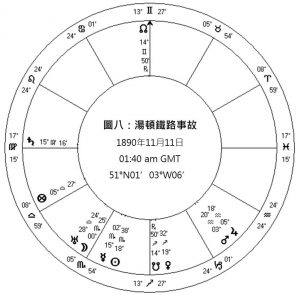
(關於湯頓火車事故盤,請見文末編審註)
Conclusion |結論
顯然十九世紀末和二十世紀初的占星家(尤其是神智學協會的成員)執意打造一個全新的占星系統,但矛盾的是奠基在據稱古代迦勒底人的系統。這些占星作家急欲向科學團體證明占星學也是一門科學,卻未意識到自己缺乏學術的嚴謹。由於完全沒有考慮到占星學理的適當性,他們迅速失去學術的根基。他們似乎沒有將引領政治、科學和科技發展的事件納入考量,這些事件被當作天王星占星效應的個別事件。天王星主管那些事務的首要原因,說是那些都是新的事物,無法使用傳統七顆行星來解釋。這樣的觀點暴露了對占星學基本原理的誤解。
一旦確立了天王星的象徵意義,將海王星和冥王星導入占星系統的方法就很清楚了。有了先例,再隨著天文學家更多的發現,也將有更多被排除。受大眾喜愛的占星作家們相信,天王星早在古老的占星智慧中佔有一席之地,而且,他們說服讀者,從早期書籍提出的象徵意義與現在普遍使用的非常相似這點便可證明。
審註:本文原刊載於美國NCGR占星研究協會 地心宇宙年鑑 2021年春季號(GEOCOSMIC JOURNAL SPRING 2021)第183-214頁,經作者授權翻譯刊登於本學院官網。經查證,該年鑑第202頁湯頓火車事故(Tauton Train Carsh)的星盤為誤植。該事故發生於1890年、而非1891年,故本文逕行修正星盤,另附相關佐證資訊如下:
1. 英文維基百科-湯頓火車事故(1890 Norton Fitzwarren rail crash)
2.Google Books-‘The Astrologer’s Magazine’ , 請見 p.135 ‘Notes’
繼續閱讀:第五集《海王星和冥王星的導入》
Uranus, Neptune, and Pluto:
An Investigation into the Sources of their Symbolism Part 04
Sue Ward (Written 2002)
The Discovery Charts
It is common practice to erect an astrological chart for an event, that is, something that has occurred and is deemed important in one way or another. Particular in this regard are the charts of the beginnings of things, for example, the beginning of a business (perhaps its incorporation), the beginning of a marriage (the wedding) and so on. In this we can include the most well known of all astrological applications, the birth chart, the beginning of life. From these charts is extracted information relating to those events and predictions made about the development of that business, marriage or life.
Such charts are set for important moments signalling the beginning of something. There are, of course, many other important moments within the lifetime of each situation or birth, but the moment nominated as the ‘birth’ moment holds the key to all that follows.
By calculating charts for the moment of discovery of each of the trans-Saturnian planets, astrologers have information regarding the ‘life’ of the act of discovery, not the object of discovery. We might find descriptions of the nature of the discovery, in this case, astronomical or heavenly, but such an event cannot be treated as a birth and so cannot provide information about the nature of the object discovered. These event charts do not provide information about the natures and qualities of the planets. Yet, it is clear that these charts were used to obtain just that kind of information.
In the following discussions of each planet, the discovery charts are provided with some of their key points and, in respect of Uranus, a demonstration given of what is being described. The logic of this practice was apparently called into question, and little interest shown in it by the time of Pluto’s discovery.
Uranus (discovered 1781)
The sources of the symbolism of Uranus are varied and comprise the chart of its discovery below, its astronomical characteristics, contemporary political events, and scientific advances, the Ouranos (Uranus) myth, Theosophical doctrine, and a misunderstanding of the astrological system. We shall look at each of these in turn, but first, it is necessary to observe the wariness of the almanac compilers in dealing with Uranus.
Early References
An investigation of the almanacs from the period subsequent to Uranus’s discovery could be expected to show the development of the acceptance of Uranus into the astrological scheme. The frequency and regularity of these publications provide a good potential source of information, especially given the dearth of other works published at that time. As has been explained, the astrological content of the almanacs generally was of a low standard when compared to that of the almanacs of earlier centuries. However, the compilers and their publishers could be expected to keep abreast of the new discoveries if only to enhance their profits by attracting more readers through novelty. Assuming that profit was a motivating factor, it could be expected that the consideration of astrological accuracy was a low priority.
It was not until 1794 that the almanac compilers first began to acknowledge the existence of Uranus, however, it is mentioned only by name or glyph.59 Sometimes it is noted on the chart included in the almanac, but not retrospectively. So, with an example nativity, Uranus is not noted on the chart if the birth predates its discovery. Additionally, by 1827, Uranus was being included in the lists of mutual aspects.
In Seed’s almanac of 1847, it is included in the ephemeris and its glyph is shown in the sections pertaining to lunar and mutual aspects.60 Referring to it as Herschel, Seed includes its aspects when dealing with the weather. He also gives Uranus a gender, that of masculine, by using the pronoun ‘he’. This compiler provides the Right Ascension and Declinations of Uranus, Vesta, Juno, Pallas and Ceres.61 The inclusion of these asteroids provides an indication of a fashion being followed, rather than an astrological precedent being set. For all that these asteroids were included in the almanacs, there is no evidence in those almanacs of their being applied or interpreted.
There is little to be found in the almanacs in terms of the meaning of Uranus, although by 1865 (84 years after its discovery), there are some cautious interpretations regarding weather predictions when Uranus was in aspect with another planet. Even a cursory perusal of the almanacs reveals that little was being said about Uranus. It suddenly appears as ‘Georgium Sidus’, then as a glyph, and its introduction into the weather forecasts gives little assistance concerning its interpretation. This reticence is in sharp contrast to the more confident approach taken by some astrologers when Pluto was discovered.
There is some evidence to suggest that the astrological symbolism of Uranus was controversial:
There has been much contention among many who pretend to calculate Nativities, concerning the power of the Georgian Planet, and the other four, which have been recently discovered [Juno, Ceres, Vesta and Pallas], I have omitted them in all my computations, being convinced that we have not had any Examples sufficient to prove the existence of their power, for plain and manifest reasons. The true and correct places and Revolutions, &c. of these Planets, are unknown to us at present; so that if we were to notice them in our Calculations and Judgment, we should soon be convinced of our Errors. I know some will say they have discovered many of their Effects in Nativities, but those who entertain an opinion of that nature, ought to produce substantial proofs of their discoveries, which I am certain they are unable to explain, tho’ if such persons are inclined to discountenance what I have here stated, I entreat them not stand any longer at a distance but come forward and publish to the world, the result of their observations, founded on legal examples and experience.62
Apparently, few astrologers were willing or able to publish such challenges. This author is not simply refuting the symbolism attributed to Uranus, he is also questioning its having any place at all within the astrological system. By ‘legal examples’ he is referring to those that conform to established rules, or to the theological sense of exemplifying by work, rather than by faith.
The Discovery Chart
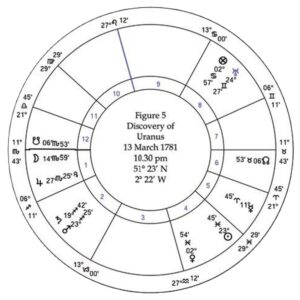
The chart of the discovery shows the generally accepted time that William Herschel (1738-1822), at his home in Bath, discovered Uranus.63 Since this discovery was momentous for more than just astrological reasons, an astrologer would have expected to find Uranus in an angle and here we find nothing of the kind. Uranus is in the 8th house, which is an uninspiring beginning for this planet.64 Little in the way of symbolism appears to have been taken from its position in this chart: the 8th is an unfortunate house, often referred to as ‘dark’, and it rules death. Uranus has never absorbed this symbolism, leaving that for Pluto.
The description offered by the chart is clear, Herschel would want the best chance of observing the planet and we can see that the Moon has yet to rise, and thus he had a dark night sky. We see Mars, the ruler of the Ascendant, representing Herschel, observing Uranus in the southern quadrant of heaven, with the Moon applying to the trine of the Sun symbolically revealing this planet to Herschel. The luminaries traditionally rule the eyes, and in this context, we see the symbolism of the telescope, and clarity of vision by the Sun’s trine with Jupiter.
The most notable configuration involving Uranus, is the close opposition it receives from Mars and, although wider, from Saturn, the two malefics. Astrologers did attribute the natures of Saturn and Mars to Uranus, and the discovery chart offers the key to that symbolism. Raphael (R.C. Smith 1795-1832) was an early exponent of this interpretation. After explaining how the ‘ancients’ applied themselves to the appearance of new ‘celestial phenomena’ (by the quarter of heaven in which they were placed, by the sign, and by any nearby fixed stars), he seems to dismiss that and advises use of a chart set for the first sight of the new planet, ‘and from which the certain cause of their appearance is more likely to become manifest to the student, than in any other manner.’
The chart he uses is timed at 10 p.m. on the 13 March 1781, since a sign of long ascension rises (Scorpio), a half-hour difference does not change the resulting chart very much. However, he notes that Uranus appears in the 9th house, where it can only be in the 8th by most house systems. He also notes that Saturn is in the 2nd house of wealth, but draws no conclusion from that.
“The horoscope of his appearance of course most plainly indicated, that the influence to be evil – and such, Astrologers have ever found it to prove. – Therefore it readily follows, that the same rules must be observed in every case, where a new celestial appearance or unusual phenomena is observed in the heavens.” 65
Without offering evidence of the proof of which he speaks, and without attempting to apply the ancient rules (the source of which is not provided), the recommended course of action is at the least incautious, and at worst, reckless. This reservation, however, was not persuasive since we find that the procedure was accepted as a practical course of action and was being applied nearly sixty years later:
“it is conceived by the best modern Astrologers that Herschell is of the nature of Saturn and Mars,… ” 66
Later still, the symbolism is reversed – the conjunction of Mars and Saturn is likened to the nature of Uranus – emphasizing the growing importance of Uranus:
when Mars is in conjunction with Saturn the result should, theoretically, be a harmonious unity, but really is not so, for the combination is in effect not unlike the influence of the planet Uranus in some respects.67
It should be emphasized at this point that the chart is timed and located for the event of the discovery of Uranus, thus it describes that event, not the planet. A chart is simply a mathematical framework in which the planets are placed, and its purpose is to facilitate delineation. The chart cannot describe its descriptors.
Astronomical Characteristics
The orbit of Uranus is eccentric, it rotates on its side when compared to the other planets in the solar system. From this is drawn its symbolism of personal eccentricity, unusual occurrences and behaviour.
Similarly, Uranus’s position in the solar system, as the first planet after Saturn, has been accepted to mean the breaking of old boundaries, these boundaries formerly represented the outermost limits of the solar system. So, when connected to a misunderstanding of the Ouranos myth (explained below), Uranus was associated with rebellion, independence, revolution, upheaval, and the overturning of established positions. Uranus represented the new and progressive, while Saturn represented all that was old, conservative, and out-dated.
It is notable that Saturn was thus associated with boundaries and limitation, a symbolism it maintains currently.
Political Events
Astrologers associated the discovery of Uranus with the American Revolution of Independence, heralded by the Boston Tea Party of 1773 and begun with the Declaration of Independence of 1776. The British were defeated at Yorktown in 1781, the year of Uranus’s discovery, ensuring American independence. The French Revolution of 1789, which led to the execution of the French monarch and the establishment of a republic, is also linked to Uranus. These were shocking events, but were never compared to the British Civil Wars (1642–1651), which had an equally traumatic and far-reaching effect on the nation. The execution of Charles I in 1649 was held to be a terrible act, even by the opponents of the Royalist party.
Mars is the planet of war, even civil war, and it is the planet of murder and mayhem. The cause of the war is not relevant, neither is the source of the enemy. Both the French and the American Revolutions were fought on the grounds of royal and government tyranny; precisely the same cause as that of the British Civil Wars, a revolution in most respects.
From the events of the modern period is drawn Uranus’s association with revolution, upheaval, independence, and freedom; these conditions being conceived as modern and thus not belonging to Mars.
Scientific Advances
The Enlightenment lasted from 1650 to 1800 and so was almost at an end when Uranus was discovered. The demand for rationalism was firmly established as the Industrial Revolution began (1700–1950). The single most important invention of the Industrial Revolution, indeed marking its beginning, and without which it could not have been, was the steam operated pump (patented by Thomas Savary, c.1650–1715), and yet, astrologers do not mention it. At no time in the published works of astrologers contemporary with the event is steam power alluded to. Only those inventions or advances that appear to tie in with the discovery of Uranus are mentioned; without reference to the preceding work that had led up to them, they were considered in isolation.
It was the application of the science of the so-called Scientific Revolution of the sixteenth and seventeenth centuries to industry which enabled the Industrial Revolution of the eighteenth century, and is, in fact, how it is defined. Astrologers lauded Uranus as the planet of science, genius, originality, and logic, which were in fact qualities and motivations belonging to the period before its discovery.
Electricity provides a good example of how this very superficial understanding of the advances of their own period led astrologers astray. Uranus, they said, rules electricity because both were discovered around the same time. Yet, William Gilbert (1544–1603) first described electricity in his work on magnetism De Magnete of 1600, it was he who established the scientific study of magnetism. The nineteenth century saw the realization of the connection between magnetism and electricity, which led to the development of electrical current. It was fifty years after Uranus’s discovery that Faraday published his laws of electromagnetic induction. He then went on to apply them to the dynamo and transformer. These were the two inventions necessary for the large-scale generation and supply of electricity.
It is not clear to what they refer when astrologers connected electricity with Uranus. However, this ‘new’ electricity (as opposed to that occurring naturally) was deemed to require a new planet to rule it. The published material does not provide any evidence of discussions about the nature of this ‘new’ form of energy, so it is not possible to judge if they had ever countenanced the fact that electricity was generated entirely from fossil fuels: ‘old’ matters that would naturally fall under the domain of ‘old’ planets (coal, for example, being ruled by Saturn). Electricity, regardless of its date of invention, is a product of a previously existing fuel used to power steam generators. The end-result, electrical current, is the manufacturing of a naturally occurring type of energy. Since that energy is hot and dry, it should be attributed to the Sun or Mars. Both offer reasonable symbolism since the Sun is the source of all heat and light, whereas the lesser malefic, Mars, rules lightning and fire.
The wonders of air and space travel, too, have been attributed to this planet. Perhaps because the first manned flight took place in 1783 in a balloon (Montgolfier). However, in a Flemish manuscript of 1325, the first known illustration was found of a string-pull helicopter.68 Heat and hydrogen produce the lift necessary for balloon flight. There is nothing new about heat and hydrogen, although found naturally, it is manufactured from steam and oxygen, and methane, or from steam and coke. Methane, or Marsh Gas, is created by the decomposition of organic matter in the absence of oxygen and is the main component of natural gas. The latter has been in use for lighting, among other things, since the second century AD. This aids understanding of space flight, too, since the greatest obstacle to achieving it was the lack of a fuel capable of producing enough thrust to lift large rockets. This was overcome with the use of liquid fuels, particularly oxygen and hydrogen.
So, all that remains of the symbolism of Uranus is the application of existing science resulting in the new technology to which Uranus has been linked. However, modern science has applied electricity in many ways: heating, lighting, and the energy necessary to drive modern appliances. Electricity keeps us warm, it gives us light, it powers tools; but fire also keeps us warm, lights our homes, and wind and water can power tools. We should not assume that electric central heating, for example, is fundamentally different from the under-floor heating systems of the Romans, or that the nature of light has been changed. An oven roasts meat or bakes cakes whether it is fuelled by electricity or solid fuel. There might be differences in efficiency, but there is no difference in essence; electricity is energy and that is well within the scope of the traditional planets.
Travel, too, is an activity that can be symbolized through the actions of the traditional planets, Mercury and the Moon. How one undertakes that travel is not of the essence, it is merely the vehicle, although its driving force might describe the vehicle. So, the old sailing ships relied on wind power, or air. The rockets that lift the spacecraft above the Earth’s gravitational pull are powered by, what is in essence, air and heat. The enormity and danger of a space flight is exactly mirrored in the journeys of exploration of earlier centuries. Was not the footprint of the first European on American soil as momentous as the footprint of the first human on the Moon’s surface?
Computers perform mathematical functions and they do it by the means of electronics and electricity. Mathematical calculations fall under the aegis of Mercury; whether of abacus or computer it remains a mercurial activity. Science is mercurial because it is of the intellect, its essence, it is of no importance to what subject that science or intellect is applied. Technology is applied science and it is not new. The printing press was once modern, cutting-edge technology. Astrology is a science, in the broader sense of the word, and is partly of the intellect, it is thus ruled by Mercury.
The Uranian symbolism of genius and originality appears, in part, to have been extrapolated from such scientific advances and inventions. The period in which the Theosophist astrologers were writing in such confident terms about Uranus, was marked by the same confidence in the scientists. Contemporary science was seen as the apex of intellectual achievement.
“We are on the threshold (we hope – necessarily so if our civilization is to survive) of a New Age … This is a democratic age, but it is also a scientific age.”69
As will be explained, originality became the watchword for astrologers, becoming the driving force in the search for astrological (in their terms, Uranian) excellence.
The push for originality and the desire for scientific acceptance go some way to explaining the often-repeated instruction to judge astrological symbolism and method through personal experience and practice. At first sight, this appears to be a sensible instruction and entirely in keeping with the tradition. However, on closer inspection, it is apparent that personal opinion is to be accepted as the rule without reference to established authority or principles. The scientific principle of experimentation was only superficially understood and they merely latched on to the principle of proving a theory through experiment and experience. Consequently, the results were insubstantial and inconclusive.
The Ouranos (Uranus) Myth
The most well known of the myths associated with Uranus is that of the god of the heavens, whose wife was Gaia, the Earth. Cronos (later associated with Saturn), was their youngest son and the only one to agree to protect his mother against Uranus. He did this by castrating his father and supplanting him in heaven.70 This is often explained by astrologers as showing the (Uranian) impulse to rebel.71But it seems to have been overlooked that Saturn has taken action against the ‘established authority’ in Uranus, and he has done that in response to his mother’s request for help, not in rebellion against his father. Cronos, or Saturn, thus becomes king of heaven and earth until overcome by his own son, Zeus (Jupiter).
The evidence points towards a later adoption by astrologers of this myth. Its having been applied erroneously, exemplifies the power of the printed word. This error has continued because few have challenged its veracity, trusting what they have read to be reliable.
Theosophical Doctrine
Education, dissemination of knowledge, ideas, and logic, plus science and technology (as explained earlier) are of Mercury. It is clear that the Theosophist astrologers were aware of the traditional symbolism and that they accepted it:
The special influence coming through each planet has been described by ancient astrologers who were evidently taught by those who knew, for as we have just hinted, modern students have found by study and practice that in the main, all that has been stated by their predecessors is true, with regard to the nature of each planet.72
However, that did not prevent them from attributing Mercury’s symbolism to Uranus. This, of course, would present problems in astrological interpretation because it would be impossible to separate the actions of the two planets; it is mentioned, if somewhat coyly, in the following quote. While the author is cautious about the natures of Uranus and Neptune in this instance, that caution is contradicted immediately afterwards, and elsewhere, by long explanations of their influences.
It may be safely stated that astrologers are quite familiar with all the temperaments coming under the various planets, save those which belong to the Uranian and Neptunian group. Of these two much more is known of the former than the latter, by so far as experience goes up to the present, Uranus and Neptune appear to represent the two extremes of a certain temperament which may be termed, for want of a better word, the spiritual.73
It is becoming clear how Mercury and Uranus were to be delineated: the seven traditional planets formed the basis of ‘exoteric’ or ‘materialistic’ astrology, whereas the new planets were part of the ‘esoteric’ or ‘spiritual’ system upon which the Theosophist astrologers placed heavy emphasis.
This emphasis is seen explicitly throughout the works of Alan Leo, and is implicit within the published work of those who came after him.
The Greeks held to the tradition [of the Chaldeans] for a time, but the study gradually became more an art than a science with them, and had so far degenerated in its teachings that little trace of the original truths can be found in the Greek authors known to us, while it was left to the Romans to finally destroy the little life that was left in Astrology as an esoteric study. Nevertheless, … it flourished in the early days of the Roman Empire, in its exoteric form, though … it became corrupted and sank into what was known as judicial Astrology, finally becoming nothing more than a form of divination by which horoscopes were cast for the hour [horary astrology].… With all due respect to modern exponents of the science, who have laboured hard in its defence, we are bound to admit that their study has been too much mixed up with considerations appertaining to ‘horary’ Astrology, a system which will not compare with the methods of astrological practice taught by the wise men of the East.74
The ‘esoteric’ astrology of Theosophist doctrine is clearly given precedence, indeed superiority, over, what they term, ‘exoteric’. It is at this point that, in the confusion of their symbolic applications, it becomes difficult to separate doctrinal motivations from those of inadequate, or biased, astrological knowledge and understanding.
So, to separate the significations of Mercury from those of Uranus, it is necessary first to accept Uranus as a planet of ‘spiritual’ or ‘esoteric’ significance. Once done, the Theosophists’ readers then need to accept the notion of ‘octave expressions’. In this case, Uranus is taken as the ‘higher octave’ of Mercury: so, for example, where Mercury rules the intellect, Uranus rules genius; where Mercury rules communications, Uranus rules communication of ‘higher’ principles.
Of course, by ‘octave expression’ is meant a more subtle and penetrating, a more refined and delicate species of emanation, of what in the main may be considered a similar constitutional quality in the lower manifestation. The essence, and perhaps even the quintessence, is implied, just as the musical tone has its octave not radically different from the lower generator, but composed of a greater number of vibrations, which in successive octaves may become so rapid and so numerous that only the most acute and finely developed ear can distinguish any sound at all,…75
Thus, Uranus’s functions operate on (or, its influence is ‘responded to’ by) those of a more advanced level of spiritual evolution.
It has been suggested that both Uranus and Neptune are the spiritual correspondents, or counterparts, of Mercury and Venus – i.e. so far as their influence in human affairs is concerned. This is quite in accord with astrological experience, and may be the reason that Uranus produces eccentrics in the intellectual worlds, and Neptune eccentrics in the artistic world. They probably are in touch with elements of thought and feeling that are wholly inconceivable to the more mundane types of Venus and Mercury.76
Eccentricity, originality, and independence are seen as new qualities, not belonging to the ‘septenary scheme’ of the traditional planets.77 These qualities belonging to their own age, (later, though, these ‘Uranian’ qualities were applied to people of previous ages in terms of genius) apparently only a new planet could express them adequately.
The problem remained, however, of how to identify those who responded to the influences of the new planets correctly and those who did not.
The chief difficulty of astrology probably lies in the fact that we cannot, in the light of our present knowledge, know which side of any particular influence will manifest; and this especially applies to the more remote bodies, which lie beyond our present norm of development. Uranus dominant may mean genius – mechanical, scientific or inspirational; or, to a lower level, independence of outlook expressed broadly in intellectual or practical directions, as in business initiative… or it may indicate lack of control or eccentricity, especially when rising, or otherwise prominent in a weak map.78
No clear answer to these problems was ever given, they held to the aspiration that astrologers of the future, through experience, would provide the solution. We see again the instruction that experience can be the only teacher.79 It was obvious to them that mistakes were being and would be made and they dealt with those through the symbolism they had given to Uranus:
“Sudden and unexpected events will occur, and act in an almost unknowable manner, which makes it impossible to judge accurately exactly what will happen under his vibrations.“80
There is never any question about the validity of Uranus’s symbolism, or of its inclusion in the astrological system at all. In this case, the planet itself is responsible for the astrologer’s inability to predict its action. The flawed logic is simply subsumed in a pretence of mysticism. He continues:
It is now certain that the ancients knew of the planet Uranus, but only those who were as far removed from the ordinary humanity as the poles came under its influence, and that for an occult and esoteric reason that cannot be explained at present.
The cause of such certainty is not forthcoming, but that does nothing to deter either Leo or the other Theosophical authors on astrology, who continue to produce similar arguments in support of their astrological system. The problem was explained through the fact that Uranus generally had little influence at that time; it was the planet of a race of men yet to come.
There is, however, one limiting condition or modifying factor, which imposes some restraint in the general practice: that is to say, as the two planets are only in evidence in comparatively few persons among those now existing, – or rather, as their true nature is only exerted and can only function when the Ego has grown up to it, as it were, – it follows that in the great majority through ignorance and abuse a ‘permutation’ occurs, because the divine and human nature are at enmity. In such cases it is to be expected that sign and planet will not agree, and the real rulership (Aquarius Uranus, Pisces Neptune) is nonplussed and held in abeyance.81
It is quite clear that they were unable to delineate Uranus satisfactorily, in that the symbolism they have attributed to it does not operate in practice, but this is never admitted, only explained away.
The next step was to insert Uranus into the scheme of planetary rulerships of the zodiacal signs. Some hesitation is in evidence, although it does not appear to have lasted for very long:
“The dominion of Uranus is indefinite, for he has no house [sign] of his own, though he is most successfully placed when in the airy triplicity.“82
The problems were multiplied once sign rulership was attributed to Uranus. Not only was it necessary to distinguish between the ‘higher’ and ‘lower’ types subject to Mercury and Uranus, but also between those Aquarians who were ruled by Saturn, the traditional ruler, and those who were ruled by Uranus, the new ruler. Having dealt with the problem of ‘higher and lower octaves’, it was a small step to manage Saturn’s unwelcome complication:
In the advanced egos found among the ranks of astrologers, theosophists, esoterics, occultists, and generators of spiritual or revealers of concealed thought in any direction, the two far-away denizens of our solar system, Uranus and Neptune, will, I feel assured, be found to dominate the respective zodiacal signs of Aquarius and Pisces.83
It is unsurprising that they should include themselves as possessors of ‘advanced egos’, and they had no qualms about extending the rulership of the new discoveries, changing the system when needed in order to accommodate them. Leo had been instructing his readers, in earlier works, that whilst no signs of rulership had been decided upon for Uranus and Neptune, they should be accepted as substitutes for the Sun and the Moon.84 Speaking of himself, he says:
He has for some time held that Uranus and Neptune rule Aquarius and Pisces respectively, and intuitively has never been able to get beyond this idea.85
Again, intuition is held in higher regard than straightforward study and reflection. No doubts or questions are raised about that since those statements are made within the context of Theosophical astrology which held that intuition was a suitable method of investigation into these matters.
Uranus was given Aquarius to rule because it was said to be the ‘higher octave’ of Mercury. In their system, Mercury was exalted in Aquarius, thus Uranus was placed into Mercury’s exaltation.86 Saturn as the old sign ruler was allowed to retain some rulership, but only over those of the lower orders:
while in some Aquarians the limiting influence of Saturn is still present, in others the higher side of Uranus’ influence is pronounced. … and those who are least prepared to respond to the higher side of Uranus will fall most under the limiting influence of Saturn. Even in the higher type of Aquarian, however, some facets of Saturn’s influence will be prominent, … where the Saturnian element is still dominant, the motive may be wholly material and selfish – while at its best it will be practical and Saturnian even when inspired by Uranian ideals. … Many widely different types will be found in this sign: unconventional (Uranus) and conventional (Saturn).87
A native born when the Sun was in Aquarius could be either Uranian or Saturnian, depending on his or her evolutionary level. Or, they could be both at once, leaving little room for any errors needing to be acknowledged as such. Since no-one really knew how to define the higher and lower types associated with the new planets, the astrologer need not feel responsibility for describing the native incorrectly.
“These rulerships [of the signs] are not only founded on tradition, but have been established by observation;“88
The ‘tradition’ in question is never revealed, but it is not of the western predictive tradition. In fact, given the low regard in which the astrology of previous ages was held (apart, that is, from what they call the Chaldean period), it would be surprising if any antecedent procedure had been used at all. The repeated mention of ‘observation’ and ‘experience’ is intended to provide scientific basis to their activities. However, they seem oblivious to the fact that their own ‘observation’ and ‘experience’ has failed to provide a reliable system in general, or a symbology for Uranus that can be consistently applied in practice.
A light examination of some historical events will provide evidence for these comments. Space exploration and travel is most firmly attributed to Uranus, so its prominence in charts relating to those matters would be expected. The first in importance is the chart for the launch of the first artificial satellite – Sputnik 1 – marking the beginning of the Space Age.89
Uranus is not at all prominently placed; it is, however, receiving sextile aspects from the planets in Libra and a trine from Saturn in Sagittarius. More important is the Moon’s position in the 7th in the airy sign of Aquarius, this is descriptive of travel (the Moon rules travel) by air (Aquarius). Venus and Saturn, too, are angular, but this chart refers to the launch of the satellite, so we should enquire after that which is above the horizon. As the ruler of the rising sign, the Sun should also be investigated as the significator of the satellite. It is disposited by Venus, the ruler of airy Libra, which is placed on the ground, in the 4th. Venus, then, represents the controllers of the satellite.
The involvement of Mars and Jupiter by conjunction with the Sun describes the propulsion system (Sun and Mars) which launched the rocket and freed (Jupiter) it from the Earth’s gravitational pull. The Moon itself is void of course and so the satellite will not complete its journey: it was not intended to return to Earth.90 Uranus is not providing the same kind of description vital to this delineation.
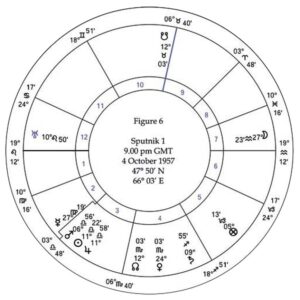
As the chart for the beginning of the Space Age, Uranus has even less to say, placed as it is in a cadent and unfortunate house. Finding the Moon in late degrees and void of course, we might doubt the predictions of the scientists and politicians, and the utility of space exploration. Having landed astronauts on the Moon, it might be questioned how much further space travel can proceed. The chart shows Mercury in Virgo in the 2nd house and Mars, Sun, and Jupiter in the 3rd in an Air sign. It is clear that the greatest benefit (if it can be described as such) to humanity derives from space technology, which has brought us great advances in communications, amongst other things.
Although the data for this chart are not certain since the Russians did not announce the launch until the next day, Uranus, if it is the significator of all things to do with space exploration, should be providing more information than it is.
Space exploration is deemed to have begun in 1903 when Russian physicist Tsiolkovsky advocated the use of liquid-fuelled rockets for space exploration. In the same year the Wright brothers successfully made the first powered and manned flight lasting twelve seconds.
The chart this time shows Uranus in the 11th house and, although this is better than the previous chart, it is still uninspiring in terms of this momentous occasion.91 We see the Moon’s prominence repeated, this time in the 10th house. If Uranus was the ruler of air travel one would expect it to be placed as the Moon is. Saturn rules the Ascendant, and so is also representative of the aircraft and its passenger. It is in the Air sign of Aquarius. Saturn is only a little above the horizon, describing the lack of height that was achieved. The fixed sign placing is not good for travel because it slows momentum, but is apt for a flight of only twelve seconds’ duration.
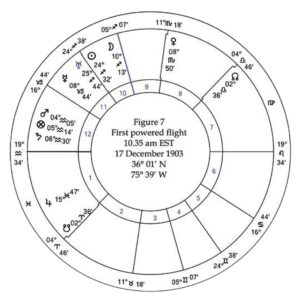
Misunderstanding of the Astrological System
Consideration needs to be given to the prime motivation of constructing a ‘new’ and ‘scientific’ astrology. The methods used to achieve that were subtractive. In the search for a scientific basis for astrology, all that might have been construed as superstition, or as not ‘rational’, was rejected. Science provided them with the licence they needed to proceed: the adoption of the scientific philosophy of proving by experiment and experience, and the questioning of all that had gone before. As discussed previously, this is explicit within the published work of the Theosophist astrologers:
Experiments on a large scale, however, brought the experience and the facts necessary to prove the permanent value of the Progressive Horoscope…92
Leo is discussing his new method of directing the horoscope, but as elsewhere, whilst using the language of scientific rigour, fails to offer any evidence of scientific basis.
A declared aim of change when added to a lack of astrological comprehension (these authors made it clear that they did not understand many of the techniques and constructs of the astrology they had inherited) cleared the way for the breaking down of the western predictive tradition. It was now possible to investigate certain astrological techniques and reject them based simply on personal experience of them as ineffective. Little seems to have been done to confirm the validity of that experience, or to minimize subjective influence. All objections were demolished in the name of ‘personal experience’, its power maintaining to this day.
The pivotal misunderstanding was that of sect (explained in ‘Astrological Fundamentals’ above). Although the following example is extracted from an early book about Pluto, its author explains how the planets have been given dominion of the signs:
SATURN is an earthy planet, previously having rule over an earth and an air sign. It retained rulership over the earthy sign of Capricorn, corresponding to its basic nature, while it had to yield the airy sign of Aquarius to the airy planet, Uranus. (Most modern writers speak of Uranus as an airy planet, but in the strict sense, it is an earthy-airy planet, acting on a material-spiritual plane. As the first of the outer planets it has the task of spiritualising the material, to unfetter and set free the earth-bound qualities of the sign Aquarius. This is why Saturn is fighting for rulership whenever it is found in the sign Aquarius…).93
He is matching the elementary nature of the planet to the element of the sign, which contradicts the system. Saturn does have an earthy nature, but, as explained previously, that is not the reason for its being the ruler of Capricorn. He continues with Jupiter, which he says is a fiery planet, previously having had rule over Sagittarius, a fiery sign, and Pisces, a watery sign. In the new scheme Jupiter maintains rulership of Sagittarius because it accords with its nature, while Pisces is given to watery Neptune. In fact, Jupiter is an airy planet and thus accords elementally with neither Sagittarius nor Pisces.
It is unnecessary to proceed with all of the other planets and signs, except Mercury (a planet having exercised these astrologers for some time because of its rulership of and exaltation in Virgo):
Lastly, the earthy planet, MERCURY, retains the earth sign, Virgo, yielding the sign Gemini to the still undiscovered twelfth planet, in the event such a planet should be discovered, which I consider certain.94
Mercury is a watery planet and, as with the others, is given rulership of Gemini and Virgo in accordance with the solar and lunar sects. Being unable to comprehend the structure of planetary dominion, and determined to accommodate Uranus, the construction of sect was overruled. It was simply a question of time to them; eventually there would be ten planets belonging to this solar system, and each sign would then have one ruler each. In this, we see the beginnings of addition, the system could not hold together by subtraction alone.
Further addition, and confusion, is evidenced in the same author’s summary:
Therefore, the five ancient planets must retain the signs having the same elements as they have themselves. A portion of the characteristics of the ancient planets will be ceded to the new planets … namely that part which corresponds to the signs yielded with their discovery. Thus, Uranus assumes the Aquarian qualities of Saturn, … There is no reason to assume that the old planets are fully divorced from the signs which they have relinquished, for they should still be retained as co-rulers. An individual sign will be definitely assigned when all twelve planets shall become known…95
It is clear from this passage that the new planets were absorbing symbolism from the signs, even though this in itself was erroneous. In the preceding quote, Saturn is said to have Aquarian qualities, when in fact, the reverse is true. Aquarius, as shown earlier, has certain descriptive qualities, one of those is its rulership by Saturn: Aquarius is Saturnian, this author is saying that Saturn is Aquarian.
When this is added to the misunderstanding of the consignification of the houses and signs, the disharmony is complete. The method was that since Aquarius ruled the 11th house (because it is the 11th sign), then Uranus as the ruler, or co-ruler, of Aquarius also ruled the 11th house. Uranus thus took on the significations of friendship; on the other hand, Aquarius took on the Uranian symbolism of humanitarianism, reform, humanism, and so on. This was extended, through the 11th house signification of friendship to the rulership of groups and group activities. Drawing again from Saturn, Uranus became the ruler of divorce and separation.
So, Aquarius, the 11th house, Saturn, and Uranus all become symbolic of the same matters. When this is put into practice, where the 11th house has a sign other than Aquarius on its cusp the confusion deepens. For example, should Aries be found on the 11th house, friends might be signified or described by Aries, its ruler Mars, a planet in the 11th house, Aquarius, any planet in that sign, Uranus, the sign it is in, possibly Saturn and its sign, although the latter is less likely these days since Uranus is usually accepted as the sole ruler of Aquarius.
The following chart, and the astrological note accompanying its data, demonstrates how all of this was put into practice.96 We have seen how certain astrological principles were rejected, and how Uranus was inserted into the system, the chart indicates the result of such changes.
These data were provided alongside mention of a similar crash in Edinburgh, the only astrological comments made was to note that Uranus was in the 3rd house and that Saturn was rising. Several house systems were used but Uranus was not found to be in the 3rd house or within 5° of that cusp (a planet within 5° of a house cusp is taken as being in that next house). Yet, the most obvious placement is that of Saturn in the 1st house. The 1st house is significant of the train and its occupants, Virgo is on that cusp, so Mercury rules the 1st. It is combust of the Sun in the 3rd house of journeys. The two most obvious arguments in the context of this event are excluded in favour of Uranus. No comment was made regarding the Edinburgh crash.
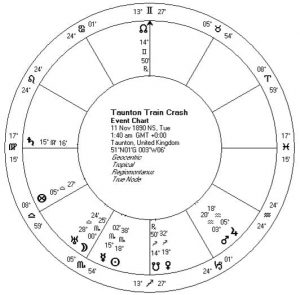
Conclusion
It is clear that the astrologers, particularly those members of the Theosophical Society, of the late nineteenth and early twentieth centuries were intent on creating a new astrological system, paradoxically, based on that allegedly belonging to the Chaldeans of old. In the rush to show the scientific community that astrology was also a science, the astrological authors did not recognize their own lack of scholarly rigour. As they pushed aside all considerations of astrological propriety, they lost ground apace with academia. No consideration seems to be have been given to the events leading up to the political events, and scientific and technological advances. They are treated as isolated incidents requiring the astrological effect of Uranus. The overarching reason for Uranus being the ruler of those matters, it is said, is that they are new; the seven traditional planets could not be used to explain these matters. Such an outlook betrays a fundamental misconception about astrology.
Once the symbolism of Uranus was established, the way was clear for the introduction of Neptune and Pluto into the system. The precedent had been set and more would be subtracted as the astronomers discovered more. The popular astrological authors were convinced that Uranus had a rightful place in the ancient wisdom of astrology. Moreover, they were convincing their readership, borne out by the very close similarities of the symbolism proposed in those early books to that now in general use.
59 John Partridge, Merlinus Liberatus (London, 1794).
60 William Seed, An Almanack (London 1847). Notice that this is a year after the discovery of Neptune.
61 Asteroids lying between the orbits of Mars and Jupiter.
62 Worsdale, Celestial Philosophy, p. 56.
63 A time of between 10am and 11am is probably more correct, but the time mentioned in the chart here is that which is most frequently mentioned during the early twentieth century.
64 This chart is erected using the Regiomontanus house system. Most other popular house systems were checked using Janus software and Uranus remains in the 8th house.
65 Raphael, A Manual of Astrology, p. 216.
66 William C. Eldon Serjeant, ed., The Astrologer’s Guide: Anima Astrologiae.’ (London, 1886 reprint of 1676 original), note p. 74. Eldon Serjeant was a Fellow of the Theosophical Society. This book comprises the 146 Considerations of Guido Bonatti and the Seven Segments of Jerome Cardan. It was first published as an English translation in 1676, translated by Henry Coley and edited by William Lilly.
67 Leo, How to Judge a Nativity, p. 41.
68 One source is https://www.newscientist.com/lastword/mg15821348-500-the-last-word/.
69 Harrison, The Measure of Life, p. xiii.
70 Pierre Grimal, The Dictionary of Classical Mythology, trans. A.R. Maxwell-Hyslop (Oxford, 1987).
71 Charles and Suzy Harvey, Principles of Astrology (London, 1999), p. 87.
72 Leo, How to Judge a Nativity, p. 28.
73 Leo, The Art of Synthesis, p. ix.
74 Leo, Astrology For All: Part I, p. vii.
75 Leo, The Art of Synthesis, p. 117.
76 Sepharial, The Manual of Astrology, p. 16.
77 Harrison, The Measure of Life, p. 21.
78 Harrison, The Measure of Life, p. 268.
79 Leo, How to Judge a Nativity, p. 47.
80 Leo, How to Judge a Nativity, p. 36.
81 Leo, The Art of Synthesis, p. 113.
82 Sepharial, The Manual of Astrology, p. 16.
83 Leo, The Art of Synthesis, p. 117.
84 Leo, How to Judge a Nativity, p. 27.
85 Leo, The Art of Synthesis, p. 117.
86 Leo, The Art of Synthesis, p. 117.
87 Harrison, The Measure of Life, p. 52.
88 Harrison, The Measure of Life, p. 26.
89 Nicholas Campion, The Book of World Horoscopes (Wellingborough, 1988), pp. 361-362. The chart is calculated by Janus using Regiomontanus cusps, and results in a difference of almost ½° on the Ascendant when compared with the chart provided by Campion.
90 It is not applying to major aspect with any planet.
91 Campion, Book of World Horoscopes, p. 361. Calculated with Janus software using Regiomontanus house system.
92 Leo, The Progressed Horoscope, p. 13.
93 Fritz Brunhubner, Pluto (Germany, 1934, revised 1971).
94 Brunhubner, Pluto
95 Brunhubner, Pluto,
96 ‘Notes’, The Astrologer’s Magazine, London, January 1891, vol. 1 no. 6, p. 135. Chart is calculated using Janus software, with Regiomontanus cusps
翻譯:Hueimin Lin/Julie Ho|編審:Maki S. Zhai
本文經作者授權翻譯刊登,其翻譯著作權歸屬 智者星象學院所有,歡迎分享本網頁連結給你的朋友,但請勿直接轉載內容。
This article is translated and published with the authorization of the author, and the copyright of this translation belongs to Astro Mages.org.
You may share the link to this page with your friends, but please do not directly reprint the content.


